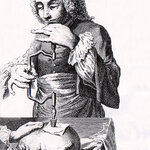Science History

When Sir Thomas More stood on the scaffold in 1535 he continued to make jokes. We don't often associate humor with executions by berserk kings over religious convictions but that is why humor has always fascinated us and it leads to questions about what is funny, how humor works at such moments, and when it is 'appropriate' to rely on a sense of humor.
Renaissance humor (1500-1700) comes under scrutiny at a conference at the University of Leicester on Friday 18th July, where experts in the literature of the period will gather for the first time to discuss Renaissance humor in some detail.
A…

In my evolution course, I note that "Darwin spent 20 years working out his ideas and gathering evidence" before releasing On the Origin of Species in 1859. I don't say he "delayed" publication purposely, though in many cases this long period from idea to outcome has been attributed to fear of the reaction from the clergy, colleagues, society at large, his wife, etc. On this issue, a few bloggers have pointed to a recent essay by John van Wyhe (2007), in which it is argued that there was no delay based on fear, only a protracted writing period. Other historians do not necessarily agree,…

"In the beginning" were more than just words — they were the beginning of printing presses and typography that brought new depths of meaning and creativity to language. For some designers and printers, the ultimate challenge is the Bible, the design of which could be affected by politics and religious beliefs, as well as by aesthetic and commercial concerns.
Patsy Watkins studied five bibles created from the mid-15th through the 20th centuries to see if the designers’ motives could be discerned within their design and typefaces. The Visual Communication Quarterly published her findings, “…

In February this year there appeared in Physics World an article entitled Constant Failure by Robert P Crease of Stony Brook University, in which he showed in how many formulae of physics and mathematics 2π turns up, rather than π. This article struck a chord with me, since even after many years I remember the feeling of “cognitive dissonance” when being taught that the formula was 2πR rather than πD.
I felt it a bit much, though, suggesting that Archimedes might have been mistaken in choosing to calculate the ratio of circumference to diameter rather than to radius. In those days, the…

The sexual and feminist revolutions were supposed to free women to enjoy casual sex just as men always had but according to Professor Anne Campbell from Durham University in the UK (1), the negative feelings reported by women after one-night stands suggest that they are not well adapted to fleeting sexual encounters.
Men are more likely to reproduce and therefore to benefit from numerous short-term partners. For women, however, quality seems to be more important than quantity. Also for women, finding partners of high genetic quality is a stronger motivator than sheer number, and it is…

Was Judgment Day at hand? At noon, it was black as night, there was lunch by candle light, the night birds came out to sing while flowers folded their petals and the animals behaved strangely. They called it 'New England's Dark Day' and it's been a mystery for almost 230 years.
The mystery has been solved, according to researchers at the University of Missouri, who say evidence from tree rings reveals massive wildfires as the likely cause, one of several theories proposed after the event but previously dismissed as 'simple and absurd.'
Limited ability for long-distance communication…

A research team from the Leioa campus of the University of the Basque Country (UPV/EHU), and led by Ms Concepción de la Rúa, has reconstructed the history of the evolution of human population and answered questions about history, using DNA extracted from skeleton remains.
Knowing the history of past populations and answering unresolved questions about them is highly interesting, more so when the information is obtained from the extraction of genetic material from historical remains. An example is the necropolis at Aldaieta (Araba) where some of these mysteries about these peoples have been…

If you read the medical news lately you may have seen a headline title Skeleton May Show Ancient Brain Surgery. This article was about an 1800 year old skeleton found in Veria, Greece. The skeleton was of a woman of about 25 years of age that suffered severe head trauma and underwent cranial surgery, unfortunately evidence shows that she did not survive.
There is an interesting history of skull surgery, known as trepanation, which comes from the Greek word trypanon, meaning auger or borer. Cranial trepanation has caught the interest of surgeons and archeologist since the 1860's, when it was…

At Paris, 18 March of 1314, on the island of the Seine in front of the Garden real, Jacques de Molay, the last Great Master of the Templars, and Geoffroy de Charny, preceptor of Normandy, were burned as heretics.
Thus finishes the history of the Knights of the Temple after two centuries. The Templars would have been in possession of the most hidden secrets of alchemy. They were first to use the IPERICO on burns and hurts from cut, like antiseptic, astringent, healing, and in order to improve humor of the soldiers that remained immobilized in bed for months.
The Templars created a mixture…

Medieval medicine gave great importance to the planets as influences in disease. The influence of the stars began at birth and influenced complexion. The continuous flow of celestial forces could change the course of disease.
The position of the planets was important in choosing the moment in which to begin cures or carry out a bloodletting. In "Regimen against the Plague", Siegmund Albich (1347-1427) invites readers not to think about the plague because that was sure to cause its appearance.
During the Middle Ages, the prevailing popular attitude in medicine was dictated by S. Ambrogio who…